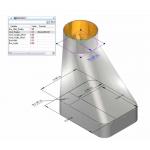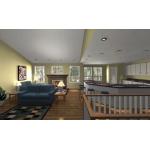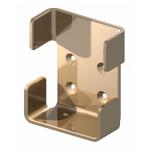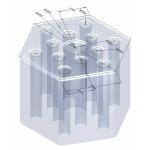Latest News
May 1, 2006
By Mike Hudspeth
When horsepower is less important than cost, IMSI’s latest introduction offers some surprising capabilities.
When you go shopping for a 3D modeler and you’re new to the game, make sure you don’t bite off more than you can chew. You don’t want to jump right into a high-end modeler right off the bat. It makes more sense to gain some experience with a lower-cost package that will introduce you to 3D concepts. Software maker IMSI does this competently with TurboCAD V12 Professional; a package with some surprising capabilities.
This latest version of TurboCAD is aimed at the modeler who has climbed beyond the hobbyist’s level but hasn’t quite gotten into sophisticated design. In the grand scheme of things, few designers fall into that category. But IMSI, which says TurboCAD is the leader in consumer CAD, is poised to fill a niche for designers seeking to move into solid modeling without shelling out several thousand dollars for a full-blown pro’s toolkit.
Under the HoodTurboCAD V12 is part-centric, meaning it’s not specifically designed for assemblies. That doesn’t mean you can’t build them, you just don’t get all the functionality that would come with true assemblies capabilities. TurboCAD V12 has a sketcher based on the D-Cubed constraint manager used by other modelers like NX, SolidWorks, and others. It means a designer can build fully constrained sketches with tangencies, verticals, horizontals, and the like (see Figure 1, below). Frankly, I was surprised that IMSI included such industry standard capability, but it’s been a part of the program since V10.5. I’d have thought it would be too cost-prohibitive, but IMSI earns kudos for having the foresight to fold the sketcher into the program.
 |
| TurboCAD V12 from IMSI |
› › Figure 1: By applying geometric and dimensional constraints to your sketches you can assure that changes can be made with predictable results. A word to the wise though: always try to fully constrain your sketches.
If you are using TurboCAD V12 as a learning tool, it’ll be a good thing to get used to how a good portion of the industry does things. Their solid and surface modeling is ACIS based, yet another common industry standard. TurboCAD V12 also uses Lightworks rendering with archives of materials and textures (see Figure 2, below).
 |
| TurboCAD V12 from IMSI |
‹ ‹ Figure 2: The Lightworks rendering engine will give you very nice graphics for your presentations and your clients’. It is used by a wide range of 3D modeling products and is some of the best on the market.
The main difference between TurboCAD Professional and TurboCAD Deluxe—the hobbysist’s version—is that TurboCAD Professional has additional 3D modeling capabilities like Booleans (Add, Subtract, Intersect and Slice). Deformable modeling, face manipulation, and Shelling make for some powerful modeling. There are many more functions that Professional has that Deluxe doesn’t. (It makes me wonder what you can do with Deluxe that would convince you to buy it. But never fear, there are still a lot of things you can do. TurboCAD Professional and TurboCAD Deluxe both have 3D primitives but TurboCAD Deluxe is wireframe only, making Professional more valuable for the designer looking to move from 2D to 3D solid modeling.)
Deformable modeling lets you bend and twist your model without losing its intelligence. It’s for those times when you need to model something that has to bend in use, say a power cord or the flexible boot on a gear shifter. TurboCAD V12 allows you to control most everything about the bends so you can model your design just how you need it. You can even bend your model like a flat pattern sheet metal part and it will understand the bends you put in (see Figure 3, below). That allows you to make changes to the model and everything updates. It’s slick.
 |
| TurboCAD V12 from IMSI |
› › Figure 3: TurboCAD V12 will allow you to add bends to your model and in effect, turn it into a sheet metal part. Everything stays parametric so changes don’t freak out your model.
Face modeling is a fun way to manipulate your models. You can assign points onto any face on your model and then push or pull them out of plane. It’s not really like manipulating a mesh. You must change a larger number of knot points with a mesh. In TurboCAD v12 you change only the points you specify. That gives you a lot of direct control.
 |
| TurboCAD V12 from IMSI |
‹ ‹ Figure 4: You can create linear patterns that use formulas like, “dimension 2 must always be X times dimension 1.”
You can do a lot with patterns in TurboCAD V12. You can create linear, radial, and patterned arrays. Linear arrays go in a straight line up and across, kind of like a table with its cells (see Figure 4, above). A radial array lets you do things like pattern a series of holes around a bolt circle. A patterned array lets you assign dimensions and constraints to a pattern that doesn’t fit either of the first two (see Figure 5, below).
TurboCAD V12 has a wide range of third-party add-ons that will increase the possibilities of what you can do. There are plenty of 3D models available to pull into your TurboCAD V12 designs, furniture, fasteners, and all kinds of things that you can use to populate your designs. Key-frame animation can add all kinds of panache to your presentations. There is a 2 1/2D CAM (no 5-axis capability) module to turn your designs into parts. Finite element analysis (FEA) will help you get to know your parts inside and out and increase your ability to get it right the first time. There is even a surface modeling module that adds GIS imported data in a limited way. With that, you can build an actual work site using imported contour data and then put your designs where they will go in the real world.
 |
| TurboCAD V12 from IMSI |
› › Figure 5: You can use pattern constraints to tie your pattern of features to particular points on your model. It’s a lot like sketching.
If you are looking to get into 3D modeling this might be a good place to start. While no product is the ultimate anything, IMSI is trying awfully hard to answer the needs of a group of designers either tasked with or interested in moving beyond 2D design and paper to the world of solid modeling. TurboCAD V12 is certainly a product worth looking at for that purpose without spending the thousands of dollars that bigger programs cost.
Mike Hudspeth is a senior designer for a global medical company and has been using a wide range of CAD products for 20 years. He, his wife, two daughters, and their cats live outside of St. Louis, MO. You can send him an e-mail about this article by clicking here. Please reference “TurboCAD V12, June 2006” in your message.
The pricing structure is interesting. TurboCAD V12 has several versions of its software. There’s a so-called Professional version ($895), a Deluxe version ($99), and a Designer ($29), which is 2D. Each version has a different price because it comes with different capabilities. IMSI also has a hobby modeler called DesignCAD 3D Max that is aimed at hobbyists and those who want to model things at home. You can get that for as little as $69.
You can find TurboCAD at Wal-Mart so getting started isn’t going to be a problem. Be careful to read the descriptions before you buy. I found the almost scattergun approach to marketing the product to be somewhat confusing. If you are willing to buy a previous version you can find some pretty great deals. I found TurboCAD 9.2 Deluxe online for $5.95. You won’t be up to date with that package, but you can upgrade to Professional later for $149. That’s quite a savings!—MH
Product Information
TurboCAD V12
IMSI Inc.
Novato, CA
Subscribe to our FREE magazine, FREE email newsletters or both!
Latest News






